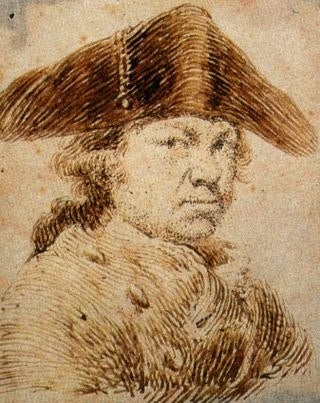Description
Francisco Goya's self -portrait of 1795 is a work that encapsulates not only the technical mastery of its creator, but also an intimate and deep reflection on the human condition and the role of the artist in society. In this work, Goya presents himself in front of the viewer with a frank and penetrating look, which has been interpreted by critics and historians as an indication of his emotional and mental state at this stage of his life.
In the portrait, Goya is shown with a dark and neutral background that allows his figure to come alive. The color palette, dominated by terrible and soft tones, opens in a play of light and shadow that adds an almost three -dimensional dimension to its face. The use of chiaroscuro is a resource master That the artist uses to highlight the features of his face, suggesting both vulnerability and robust confidence. His beard and hair, which seem upset, contrast with the neatness of his clothing, a dark coat that is a personal and professional story, since the artist became one of the most prominent painters of his time.
Goya's expression is an amalgam of determination and melancholy, a reflection of a man who has experienced the agitation of his time. In 1795, Europe was at a crossroads of political and social changes, and Goya, deeply influenced by these movements, seems to offer the viewer a look at the soul of an artist who meditates over his place in a world in crisis. This self -portrait is not limited to being a simple representation, but is transformed into an opportunity for Goya to expose his own existential narrative, uncertainty and introspection that accompanied him.
In the context of Goya's artistic production, this piece is in a period in which the artist was developing his personal style, gradually moving away from the most rigid rules of the Baroque and approaching a more modern language. His portraits and self -portraits are known for their direct relationship with the individual portrayed, visually communicating emotions and thoughts through the minimum details. This particular work evokes similarities with other notable self -portraits of art history, ranging from Rembrandt to the most contemporary works, all of them exploring the self on the canvas.
It is interesting to note that Goya would continue to develop this issue of self -knowledge and self -observation in later masterpieces. It is often considered the precursor of romanticism and modern art, and this self -portrait serves as a turning point that visualizes the evolution of its thinking and style. In him, not only the artist observes himself, but invites the audience to participate in his reflection, undressing the creative process and the challenges inherent in search of artistic meaning.
In conclusion, Goya's self -portrait of 1795 is a work rich in meaning, technical and emotion, which allows access to the mentality of one of the greatest masters of Spanish painting. The direct connection between the artist and the spectator that establishes this work is a testimony not only of Goya's talent, but of his ability to express, through his art, the concerns of his time and his own life experience. Thus, this painting stands, not only as a portrait of Francisco Goya, but as a portrait of the human spirit itself.
KUADROS ©, a famous paint on your wall.
Hand-made oil painting reproductions, with the quality of professional artists and the distinctive seal of KUADROS ©.
Reproduction service paintings With a guarantee of satisfaction. If you are not completely satisfied with the replica of your painting, we refund your money 100%.

